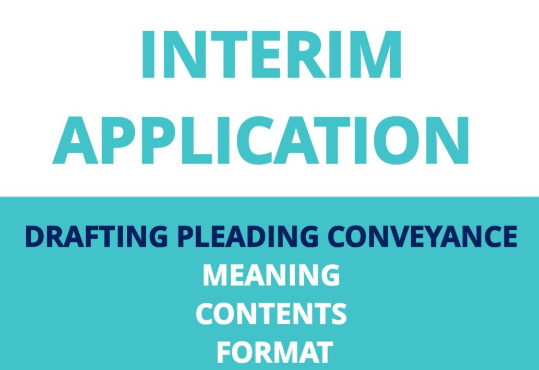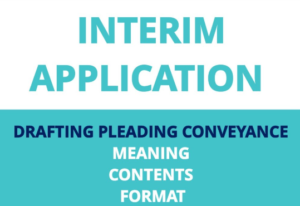
Introduction
An interim application is an application filed during the pendency of a civil suit or proceeding to seek immediate or urgent relief. The purpose is to protect the rights of a party, prevent the defeat of justice, or maintain status quo until the final adjudication.These applications are temporary in nature and are governed primarily by the Code of Civil Procedure, 1908 (CPC), and supplemented by judicial precedents.
🔹 OBJECTIVES OF INTERIM APPLICATIONS
-
Preserve subject matter of the suit
-
Prevent irreparable harm
-
Secure justice and avoid futility of the final judgment
-
Provide urgent relief when waiting for final decree may cause injustice
-
Prevent abuse of legal process
CLASSIFICATION OF INTERIM APPLICATIONS
✅ A. Temporary Injunction (Order 39, Rules 1 & 2 CPC)
-
Used when one party fears that the other will act in a way that harms or affects the subject matter of the suit.
-
Examples:
-
Preventing sale of a disputed property
-
Preventing publication of defamatory content
-
-
Conditions to Grant:
-
Prima facie case
-
Irreparable injury
-
Balance of convenience
-
Ex Parte Injunction (Rule 3) can be granted in urgent cases but must be followed by notice to the other party and a hearing.
Landmark Case:
Dalpat Kumar v. Prahlad Singh (1992)
SC emphasized that interim relief cannot be claimed as a matter of right; discretion lies with the court.
✅ B. Interim Mandatory Injunction
-
Forces a party to do something rather than not do something.
-
Granted in exceptional cases, where urgent action is needed to restore status quo ante.
-
Example: Reinstating an employee illegally dismissed pending final adjudication.
✅ C. Attachment Before Judgment (Order 38 Rule 5 CPC)
-
Ensures that the defendant does not dispose of or hide property to avoid judgment enforcement.
-
Court may order attachment of property if:
-
The defendant intends to defeat a future decree.
-
There is a strong case against the defendant.
-
Procedure:
-
Show cause notice is issued to the defendant.
-
If no satisfactory response, order of conditional or final attachment is passed.
Case:
-
Premraj Mundra v. Md. Maneck Gazi (1951) — Calcutta HC laid down principles for granting attachment before judgment.
✅ D. Appointment of Receiver (Order 40 Rule 1 CPC)
-
Receiver is appointed to take custody, manage, or preserve property during litigation.
-
Used when property is at risk or if both parties claim rights over it.
-
Receiver submits periodic reports and works under court’s supervision.
✅ E. Security for Costs (Order 25 CPC)
-
Defendant can apply asking plaintiff to deposit security to cover litigation costs if the suit fails.
-
Usually applied when:
-
Plaintiff resides outside jurisdiction.
-
Doubts about plaintiff’s solvency.
-
✅ F. Commission for Evidence or Local Investigation (Order 26 CPC)
-
Local Inspection (Rule 9) – Court appoints commissioner to inspect land/building in dispute.
-
Recording Evidence (Rule 4A) – When witness is aged, infirm, or cannot attend court.
✅ G. Stay of Suit or Proceedings (Section 10 & Section 151 CPC)
-
Court can stay proceedings:
-
If similar issues are pending in another competent court (Section 10 – Res Sub Judice)
-
Or under inherent powers (Section 151) if justice demands.
-
✅ H. Restitution (Section 144 CPC)
-
When a decree is reversed or varied on appeal, the aggrieved party can file an interim application for restitution of benefits conferred under the earlier decree.
✅ I. Inherent Powers (Section 151 CPC)
-
When no specific remedy is provided, courts may grant interim relief using inherent powers.
-
Example: Preventing abuse of process or securing ends of justice.
Case:
Manohar Lal Chopra v. Rai Bahadur Rao Raja Seth Hiralal (1962)
Supreme Court held that courts can grant injunctions under Section 151 even if not covered by Order 39.
PROCEDURE FOR FILING INTERIM APPLICATION
-
Draft Interim Application
-
Mention relevant CPC provision
-
Describe urgency and need for relief
-
Attach supporting documents
-
-
Affidavit
-
Affidavit must be filed to support the facts claimed
-
-
Notice
-
Opposite party is usually notified unless relief is sought ex parte
-
-
Hearing
-
Court hears both sides and considers:
-
Merits of main suit
-
Urgency
-
Conduct of parties
-
-
-
Order
-
Can be conditional, time-bound, or subject to modification
-
🔹 IMPORTANT PRINCIPLES IN GRANTING INTERIM RELIEF
Principle Meaning Prima facie case The applicant must show there’s a serious question to be tried Irreparable harm Damage which cannot be compensated by money alone Balance of convenience More harm to applicant if relief is denied than to the respondent if granted
🔹 EFFECT AND ENFORCEMENT
-
Interim orders are binding and must be followed.
-
Violation can lead to contempt of court, attachment of property, or civil arrest.
-
These orders can be modified, extended, or vacated depending on the circumstances.
🔹 APPEAL & REVISION OF INTERIM ORDERS
-
Interim orders are appealable under Order 43 Rule 1 CPC in certain cases.
-
Revision under Section 115 CPC may be filed if no appeal is provided but there is jurisdictional error or legal mistake.
🧠 TIP:
Courts are cautious with interim relief. Filing a frivolous or dishonest interim application can result in heavy costs or rejection. Applicants must present clean hands and act in good faith.
-
